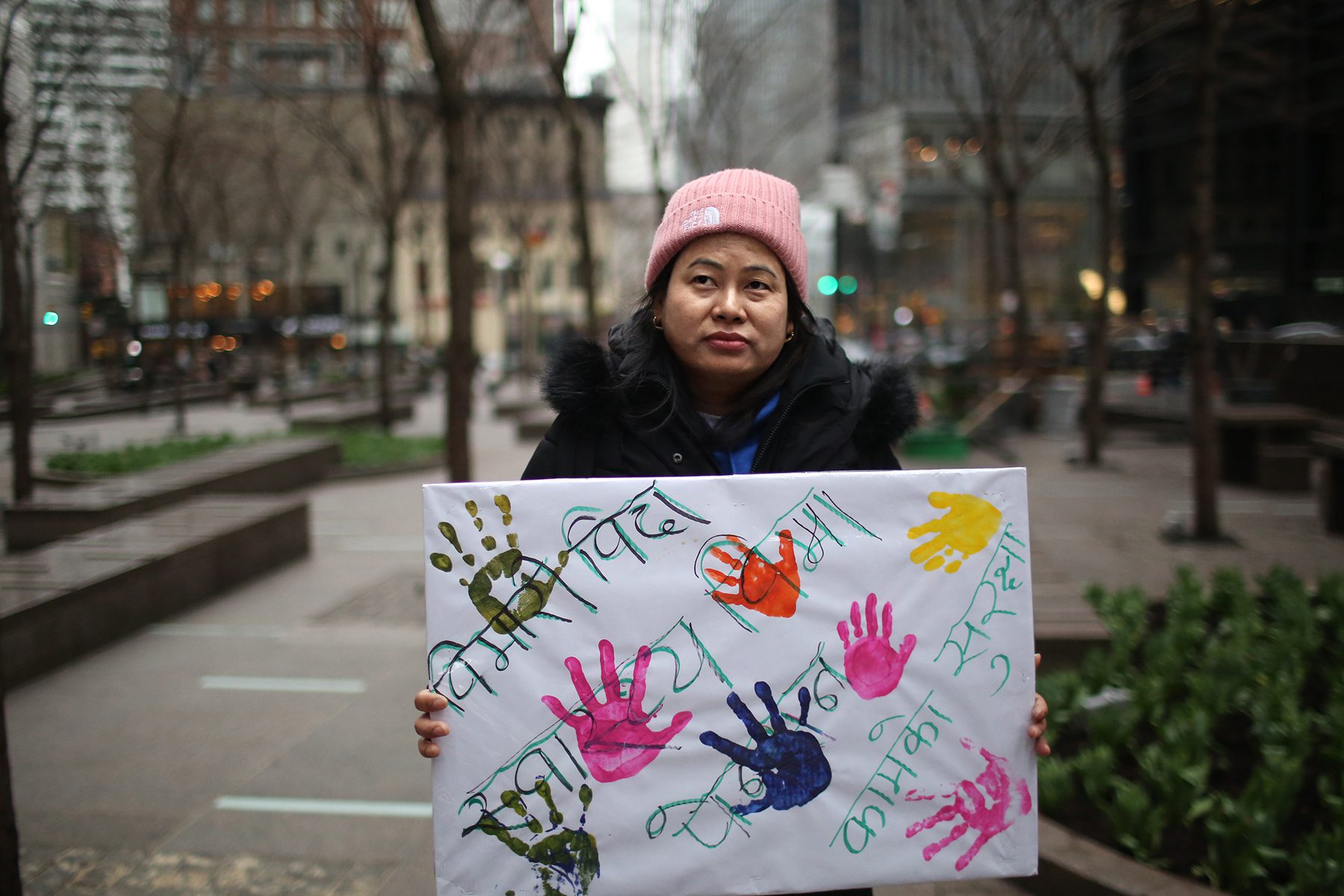Blanca Vidal felt the water drip from the broken pedicure bowl onto her sneakers as she bent over the work-worn toes of Staten Island housekeepers. For almost 11 hours a day on the weekends, she buffed, filed and polished toenails at a nail salon there, her hands and face bare of protective equipment, her feet covered in towels to catch filthy dripping water.
When she was allowed to do a manicure, something usually reserved for techs with more experience or who had the owners’ favor, she’d perch on a stack of magazines that had been placed on a defective chair. The salon owners, three Chinese women who managed about a dozen nail technicians at Vogue Nail & Spa, hadn’t bothered to replace it, Vidal said.
She had no breaks. If the owners saw her eating, they’d rush her to finish or encourage her to bring soup — it’s faster to digest, she remembered they told her. If she went to use the bathroom, they’d knock on the door and tell her to hurry. If she finished late, she was expected to stay and clean the salon.
For that work, Vidal, an immigrant from Mexico, started out earning a flat rate of $60 a day — under $6 an hour — and little more than $2 or $3 in tips per customer.
“I always had the mentality that this is a free country. I thought the country allowed the owners to treat us like this,” Vidal said. “I thought that, as an immigrant, I had to go through that — that immigrants have no rights in this country.”
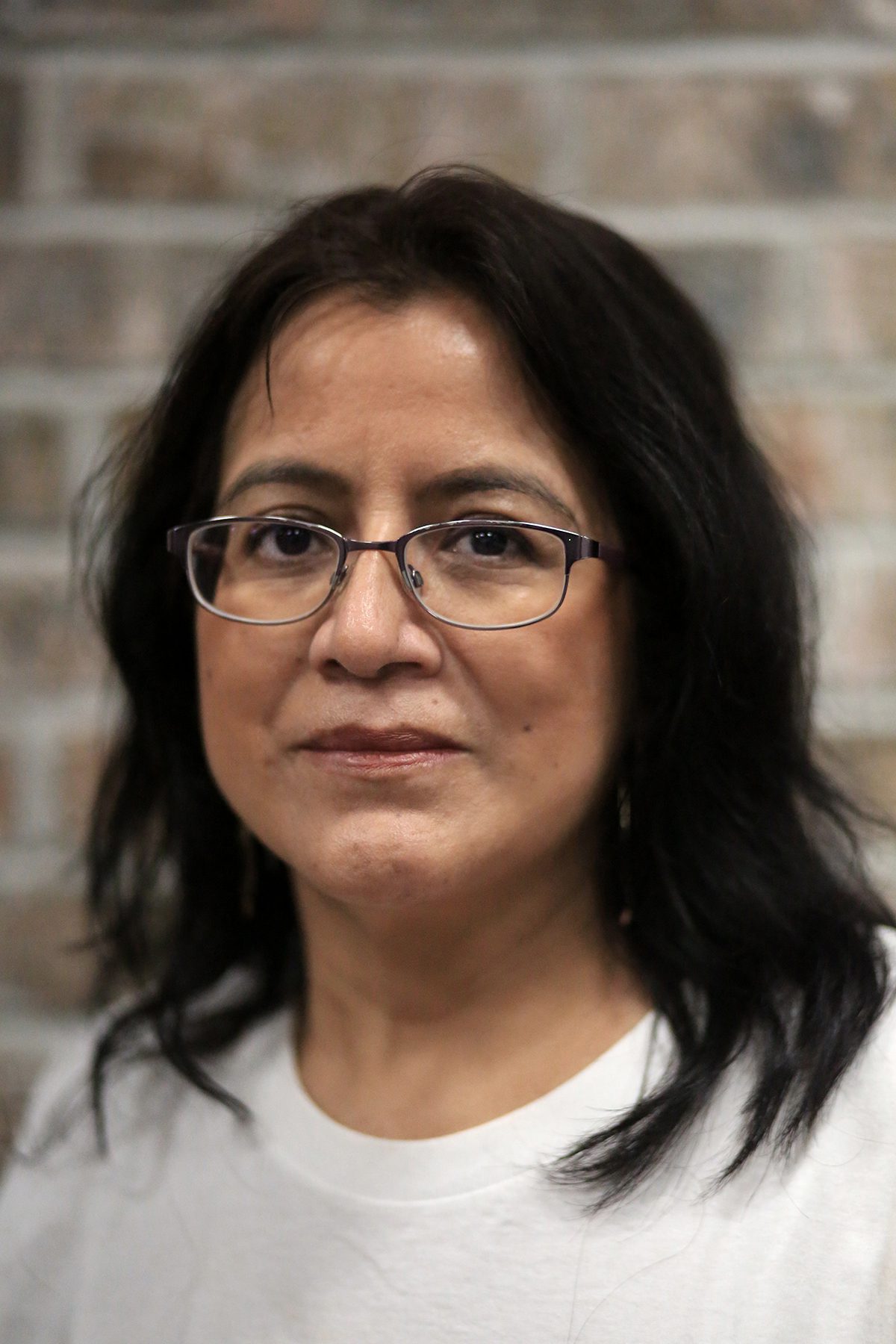
It was 2015, right when New York City was passing a flurry of new laws to protect nail tech workers’ rights, pay and safety after years of worker organizing and a scathing story in The New York Times that stripped any veneer from the city’s nail salons.
But those promised improvements had not yet reached Vidal. Even now, they still haven’t reached many.
Seven years and several new laws later, the conditions Vidal lived through are still common across New York City — the place with the highest concentration of salons in the country. Even as the city has attempted to curb rampant exploitation, wage theft and abuse, the sheer volume of salons – nearly 4,000 registered – has made it difficult. A business model with extreme competition at the center has kept prices low, hampering attempts to raise wages for workers.
That stagnation has birthed the resurgence of a worker movement, led by women of color, who are pushing to pass a new law in the state this year that would give techs a power they feel the industry has stripped from them: to create new standards, wage rules with real teeth and reshape the industry to work for them, too.
If successful, those changes could finally shift a power dynamic that has favored employers for decades. About 94 percent of nail techs are Asian, Pacific Islanders or Latinx, and 88 percent are immigrants, according to a recent report by Cornell University’s ILR Worker Institute. About 85 percent are women, and few are English speakers — many are afraid to speak up against their employers, the report found.
In Vidal’s salon, there were racial dynamics at play that are common across the industry. Korean workers are regarded highly, followed by Chinese workers, while South Asian and Latinx workers were at the bottom of the rung. The Latinas at Vogue Nail & Spa got pink aprons as uniforms while the Chinese workers got more protective tunics that helped shield them from hazardous chemicals in nail products, including known carcinogens, that have been linked to headaches, skin issues and some eye, nose and throat irritation.
The Latinas were also the only ones scheduled to clean the bathroom, Vidal said, and they often were given the worst pedicure assignments — the least desirable and most difficult job — and the fewest manicures.
-
More from The 19th
- Part-time work becomes part of equation that puts Asian-American women behind in pay equity
- Tipped restaurant workers reported more harassment during the pandemic, especially women of color
- Inflation is hurting women at the grocery store. Some are eating less in order to feed their families.
When new salon regulations passed in 2016 — including a mandatory Bill of Rights detailing techs’ entitlement to breaks, tips and minimum hourly pay — Vidal and her other Latina coworkers started to whisper at the subway stop in the morning about their treatment at the salon. They thought about fighting back.
“We realized that as immigrant workers, it doesn’t matter our race or condition or immigration status — we have rights,” Vidal said. “That’s when I realized it wasn’t the government [allowing the mistreatment to happen], it was the owners who come to own us as workers.”
They decided to lodge a complaint with the Department of Labor, and later the City of New York Commission on Human Rights, detailing the lack of breaks, wage theft and unequal treatment of Latinx workers. Vidal said the owners tried to intimidate them to reveal who had lodged the complaint, promising to give more hours to workers who spoke up. The workers never wavered.
It wasn’t until a hearing in the Department of Labor case, which detailed retaliation taken against them, that the salon’s five Latinas faced their employers for the first time. They won the case in 2018. After losing their attorney on the Human Rights Commission case however, Vidal said, it never progressed further.
The win should have felt like victory: Each of the five plaintiffs got $6,000, Vidal said. But she’d told the judge it wasn’t money she was after. She wanted change.
“But when you file a lawsuit, there is no change,” she said in Spanish. “One simply gets some money, but the problem remains.”
The salon is now called Sweety Nail & Spa. Attempts to reach the owners were unsuccessful and met with different responses — that the salon changed ownership or that the owners were not there. Business records show Vogue closed and later reopened as Sweety in 2019 using the same phone number and website, and with at least one of Vogue’s prior owners, Wen Mei Huang, listed as an officer.
By this year, nearly all of the nail salon bills passed since 2015 have been fully phased in.
At the end of 2020, nail salon workers were taken out from under the tipped wage, which had made it legal to pay them under minimum wage as long as tips made up the difference — something that rarely happened. In most salons, workers were paid daily rates that started as low as $25 a day for 12-hour days, according to the Cornell report’s survey of nail salon workers and interviews with techs. Now, all nail salon workers in New York City are required by law to earn $15 an hour. A requirement that salons complete installations of compliant ventilation systems has been delayed twice, but is expected to be enacted later this year.
But each new bill has been like trying to fix a chip in a manicure: It helps for a time but more chips always emerge — until the entire thing has to be removed and painted over anew.
Workers, including half a dozen interviewed by The 19th, said that many salons have reduced hours in order to comply with the $15 minimum wage, but still pay the same wages overall as before the law. Some salons still don’t offer protective equipment, and the old tactics of intimidation by owners and limiting meals and breaks remain. Most workers don’t get a single day of paid sick leave, vacation or any health care benefits.
Even if owners want to comply with the new rules, stiff competition makes it difficult to do so, employers said. Manicures in New York cost an average of about $13, nearly half the average price nationwide. Raising prices could mean losing customers to the salon around the corner or shutting down entirely.
The solution for workers could be held in the Nail Salon Minimum Standards Council Act, a bill proposed this year that calls for a group of 15 workers and owners to devise new minimum standards for the New York industry, such as what the minimum cost of a pedicure must be. A diverse group of nail techs would work with owners to arrive at the new rules — which could cover a range of topics including sick pay, scheduling requirements and safety protections.
New York Democratic state Sen. Jessica Ramos, who proposed the legislation in January, said it was out of a desire to “end the feminization of poverty.” The average hourly wage of a salon worker in New York City is $13.74, less than that of child care workers, fast food workers and housekeepers, fields also dominated by women that are among the lowest paid jobs nationwide.
“By creating standards across the industry that removes competition for the sake of prices …Let’s say a manicure becomes $20 or $30 — what they are competing on is service and convenience and creativity,” Ramos told The 19th.
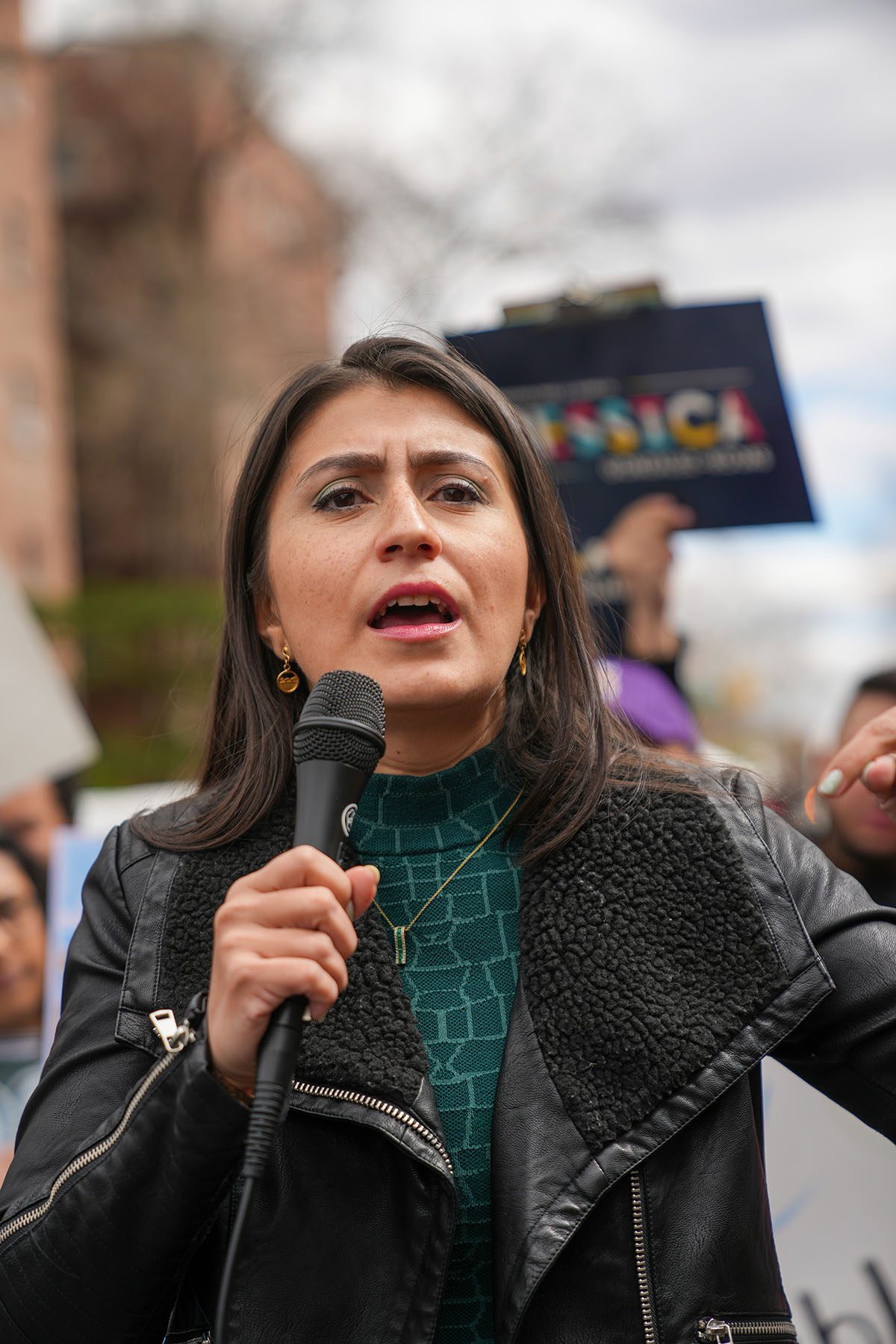
The nail salon council would work to deliver recommendations to the New York state labor commissioner, who would then be responsible for deciding which recommendations to enact and enforce any new rules that emerge, a challenge in and of itself after enforcement of the current bills has already proven tricky thanks to shrinking budgets.
A council could also help overcome a culture of silence and rebalance the power scales, said Kate Andrias, a law professor at Columbia University. It was a wage board in New York, composed of labor, business and public representatives, that successfully led to fast food workers obtaining a $15 an hour minimum wage in 2015.
“It can be a way for organizations to continue to grow participation so that workers know that they have a voice in how the industry is being regulated,” she said. “Ideally, that then helps them feel more confident about bringing concerns forward and pursuing violations.”
But questions of whether groups can come to an agreement, and whether those recommendations can become law, are not insignificant hurdles, said Nicole Hallett, associate clinical professor of law and director of the Immigrants’ Rights Clinic at the University of Chicago Law School.
“At this point I can’t tell whether it’s going to be an effective policy or not,” she said. “I think it’s right that we need to be in conversation with employers, we can’t have an adversarial position with them — they need to adjust their expectations.”
Workers like Vidal feel the bill is an opportunity to right past mistakes. She’s been working at salons, from New Jersey to Manhattan to Staten Island, since she moved to the United States in 2005, and many of the problems in the industry carried from place to place.
“If I changed jobs, it didn’t make a difference because in all the salons there is exploitation,” Vidal shouted into a megaphone at a rally for the new legislation in early April in Manhattan. She carried a large cardboard cutout of an orange bottle of nail polish with the words “health,” “dignity” and “justice” written on it in big white letters.
“We don’t want salons to close; we want them to remain open,” she told a crowd of about 100 Spanish- and Nepali-speaking nail techs and a handful of salon owners who gathered for the demonstration on a brisk morning in Zuccotti Park. Vidal was the last to speak.
“We want the health, dignity and lives of the nail salon workers to be respected,” she said, as the crowd started chanting her name. Blanca, Blanca, Blanca.
When Vidal first arrived in the United States with her cousin, nail salons were the only places that would take her. The jobs required little to no English, and there was plenty of demand. Prior to the COVID-19 pandemic, employment in the nail salon industry in New York had been steadily increasing by about 9.5 percent a year, according to the Bureau of Labor Statistics.
It’s an industry that has flourished in New York City on the backs of immigrant workers.
In the 1980s, Vietnamese immigrants helped turn nails from a luxury option for wealthy clients at hair salons to a growing industry for people across the socioeconomic spectrum. Salons cropped up in neighborhoods across the city, and with little overhead, they became a pathway to business ownership. Many current nail salon owners are former nail techs.
When Vidal started working for $25 a day at a salon in Staten Island, she didn’t work on nails. New entrants get the least coveted jobs, cleaning and folding towels and assisting the techs. If they are there long enough, they begin to learn how to do pedicures. It would be years before Vidal learned to do manicures.
In those early years, she and her cousin lived with 10 other people in a four-bedroom house with a living room they’d converted into a bedroom. Vidal knew only her cousin and her cousin’s friend — the rest were all strangers.
Those kinds of crowded living conditions are still common despite new regulations that were supposed to improve pay for techs, and the onset of the pandemic has only further intensified the need among workers.
Most salons were closed for about six months, and the ones that have returned have done so with reduced capacity that has left workers fighting for even part-time hours.
At Adhikaar, a community organization that has been representing Nepali-speaking nail salon techs since 2005, every story has similar throughlines: Most workers had been reduced from full time to part time. Most had been out of work at least six months, if not a year or more due to the pandemic. Cleaning procedures are more extensive now, yet protective equipment is still hard to come by.
Menuka Simkhada, a nail tech in Queens who has suffered from headaches since she started working in salons in 2016, said that even with some new ventilation, the amount of chemicals they handle on a daily basis now almost negates the changes.
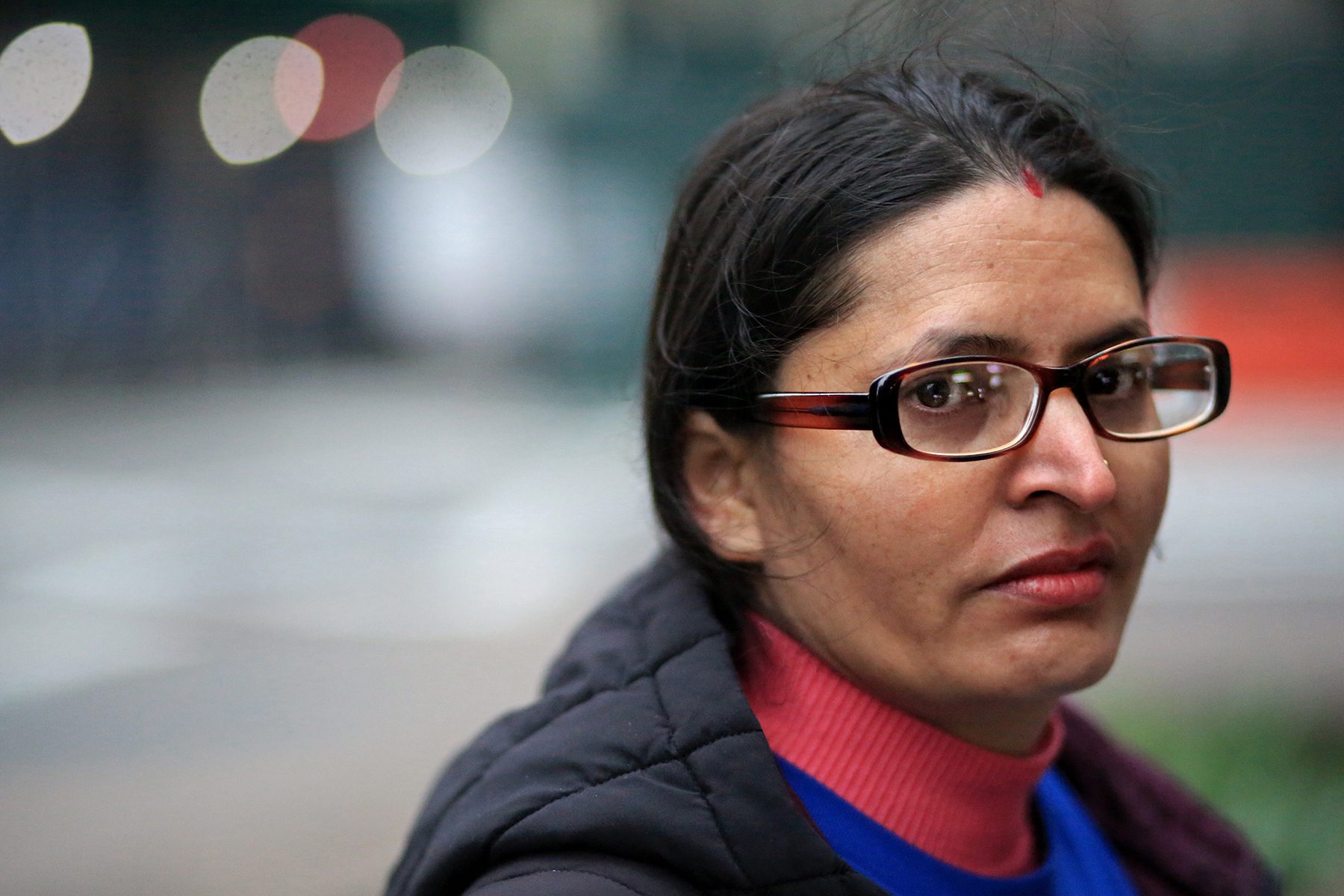
“As soon as I enter the nail salon, the smell — with the powders and the other chemicals that are there — it’s very strong,” said Simkhada, 34. “That [alone] gives me headaches. A lot of my friends have also expressed they feel similar.”
Simkhada earns $11 an hour working part time three to four days a week, a less desirable schedule she suspects she gets because, as a parent to a 7-year-old and a 14-year-old, she sometimes has to call out when child care falls through. In seven years, she’s never had access to a sick day or a vacation day.
A common refrain is that workers are at the mercy of owners. If the day is slow, if it’s raining, if it’s snowing, they might get called to stay home or sent home early. Unpredictable schedules make life that way, too.
Legislation “passed but it hasn’t passed for us — it hasn’t come to us,” said Tsering Lhamo, a nail tech in Brooklyn.
Goma Yonjan Gurung, a nail tech since 1995 who has been involved with the Nepali worker movement since its inception in 2005, said many of the complaints are still the same — workers who aren’t getting paid enough, who have never seen a day off.
She hoped the laws in 2015 and 2016 would change things, but the response has been disheartening, she said. A $15 an hour wage increase hasn’t really meant workers see that money after owners started to cut hours.
“How are we going to survive like this? New York City is very expensive,” she said. “I have worked in this industry for 25 years, but I have never gotten a pension or a sick day at all.”
What’s missing isn’t a bill raising wages or creating sick time, but a cultural change, said Hallett, the law professor who has worked on cases involving nail salon worker wage theft. That’s why workers hope a council might help — it would be an opportunity to get together with owners to devise a new path that could work for everyone, so that the same issues don’t continue to resurface.
“Employers believe that the laws don’t matter and they believe they are not going to get caught. It may still be in the employer’s economic interest to commit wage theft because there is not a high chance [they’ll get caught]” she said. “Consumers have to accept higher prices — that’s just the bottom line. If you want to get an ethical manicure you are going to have to pay more.”
The pandemic has created a new opening to talk about those issues in a way that gets to their core. Across the country, workers in low-wage fields that have little history of organizing have begun to do so, many of them led by women of color. It’s a call not just for higher pay, but benefits, child care, health and safety — a reimagining of one’s relationship with one’s work.
Gurung said the moment has helped lift her. Because of the pandemic, the salon she worked in for 17 years shuttered with little notice. The owner called one day in April 2020 and said they were closing. “They didn’t say, ‘How are you? How are you doing?’” Gurung said. They just closed. She spent the next few months organizing food drives and safety gear drives, going as far as taking the items to coworkers’ homes in her husband’s car. Because of language barriers, many people didn’t know where to ask for help or even exactly what was happening around them.
It strengthened her resolve. Now she works with Adhikaar organizing workers around the new legislation, hoping the council will help create more stable working hours and allow workers access to paid leave and paid holidays.
She is hopeful. Cautious. It’s “better than nothing,” she said.
On the morning of the rally to announce the worker-led push for the new bill in New York, Gurung was at Adhikaar’s small offices in Queens, helping lead a prayer to the Hindu God Ganesha, remover of obstacles. They lit two candles and placed them inside an orange, where they burned through their wicks by the time Gurung and 30 other nail salon techs headed out, MetroCards in hand, toward Zuccotti Park.
Wearing blue Adhikaar T-shirts, the workers walked in a group toward the subway station. They passed people in their front yards who watched as they strode by. The workers packed tightly, most standing, into a sweltering train car that would take them to the World Trade Center exit 45 minutes away. Toward the end of the ride, when the car cleared enough, Gurung led them in a song they’d written in Nepali: Better pay! Pensions! Paid leave!
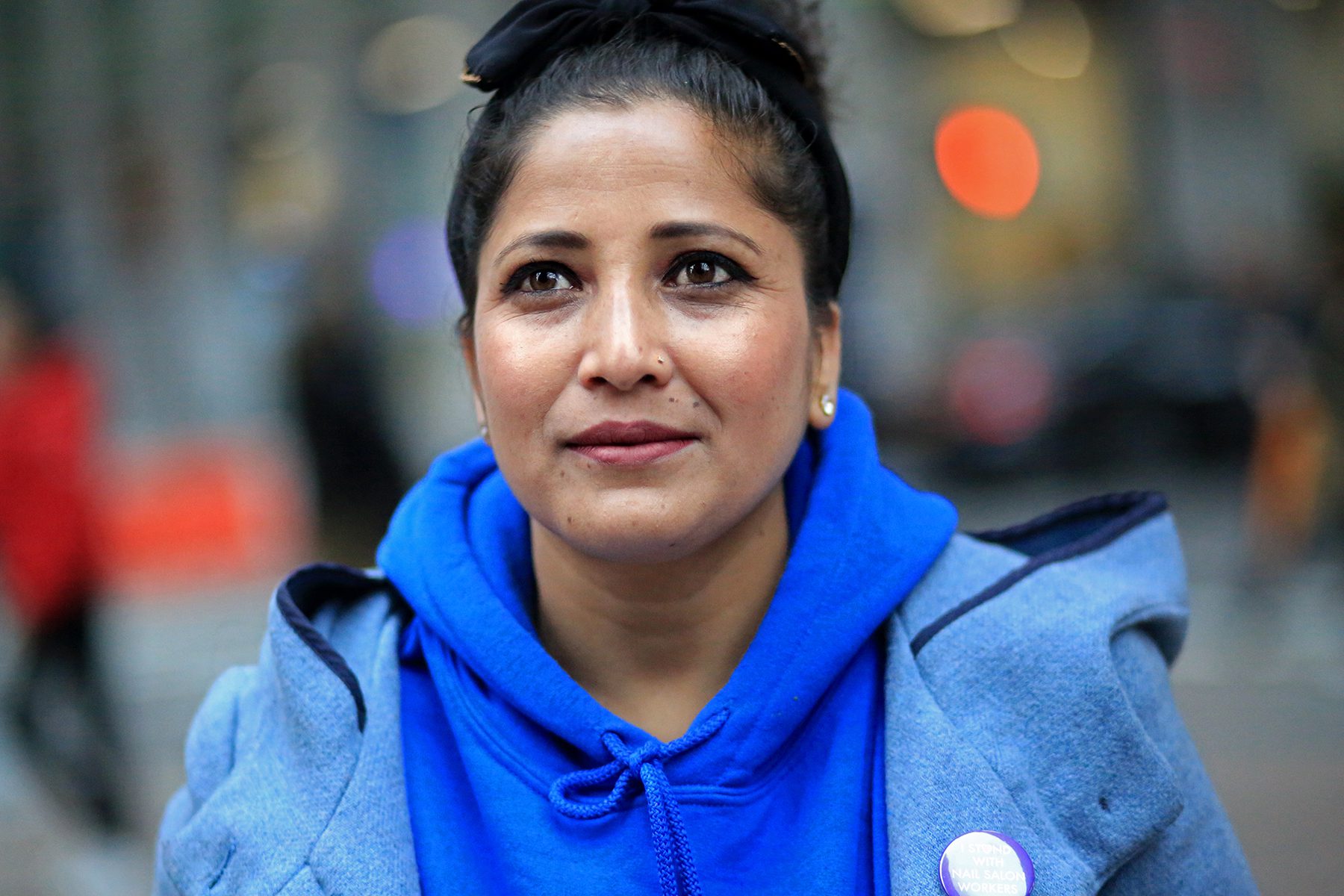
They’d sing it again an hour later, gathered under the 70-foot red steel Joie de Vivre statue at the park as Gurung and Simkhada danced. Vidal had joined them by then along with a contingent of Spanish-speaking workers who chanted, estamos en la lucha. We are in the fight.
The fight they detailed that morning was a foundational one: They want a true minimum wage, nothing more. They want sick time or vacation time. They want the holidays all other workers get off. They want guaranteed scheduling so workers don’t find themselves, snow up to their knees, getting a call from their bosses to stay home after all.
“We give 10, 20, even 30 years to this industry and at the end of our careers, we go home with our hands empty. The government does not take care of us. Our employers will not take care of us. And so who will take care of us?” asked one worker, Maya, through a megaphone in Nepali. “What we are asking for is not anything extra.”
She called the legislation a chance for a “new morning.”
As a nail salon worker, Vidal likely won’t see that new morning. After the complaint she won against her nail salon in Staten Island, she left the salon for one with better conditions and later started working part-time with a nail tech training school run by the New York Committee for Occupational Safety and Health (NYCOSH) to help workers get licensed and train them on their rights. In 2021, she left salons for good and took on that job full time, helping to teach classes, register workers for exams and renew licenses.
In that role, her life has finally changed. For the first time after 15 years living in different homes with strangers and other family to help pay rent, she lives alone in her home with her husband and 11-year-old daughter, Fatima. She often thinks back to when they had to count all the coins they had saved just to make rent, or when she had to teach her daughter to ask her before she wanted to go to the bathroom, fearing one of the men who lived with them would follow her in.
“One day she told me, ‘It feels weird not saying, I’m going to the bathroom, Mom,’” Vidal said.
The dawn she hopes for now is for the workers she sees at the school, who are still complaining of the same things she fought for years ago.
“The workers identify with me because they know I came from the same,” Vidal said. “I suffered all of that bad treatment, but I also fought against it. I tried, even when I didn’t know I had rights … to find a way for me and my coworkers to not have to go through that.”
Standing at the edge of the crowd that April morning, she was encouraged by how many people turned out. It was a Thursday — a busy day at salons — but workers had taken the day off anyway, knowing it meant no pay.
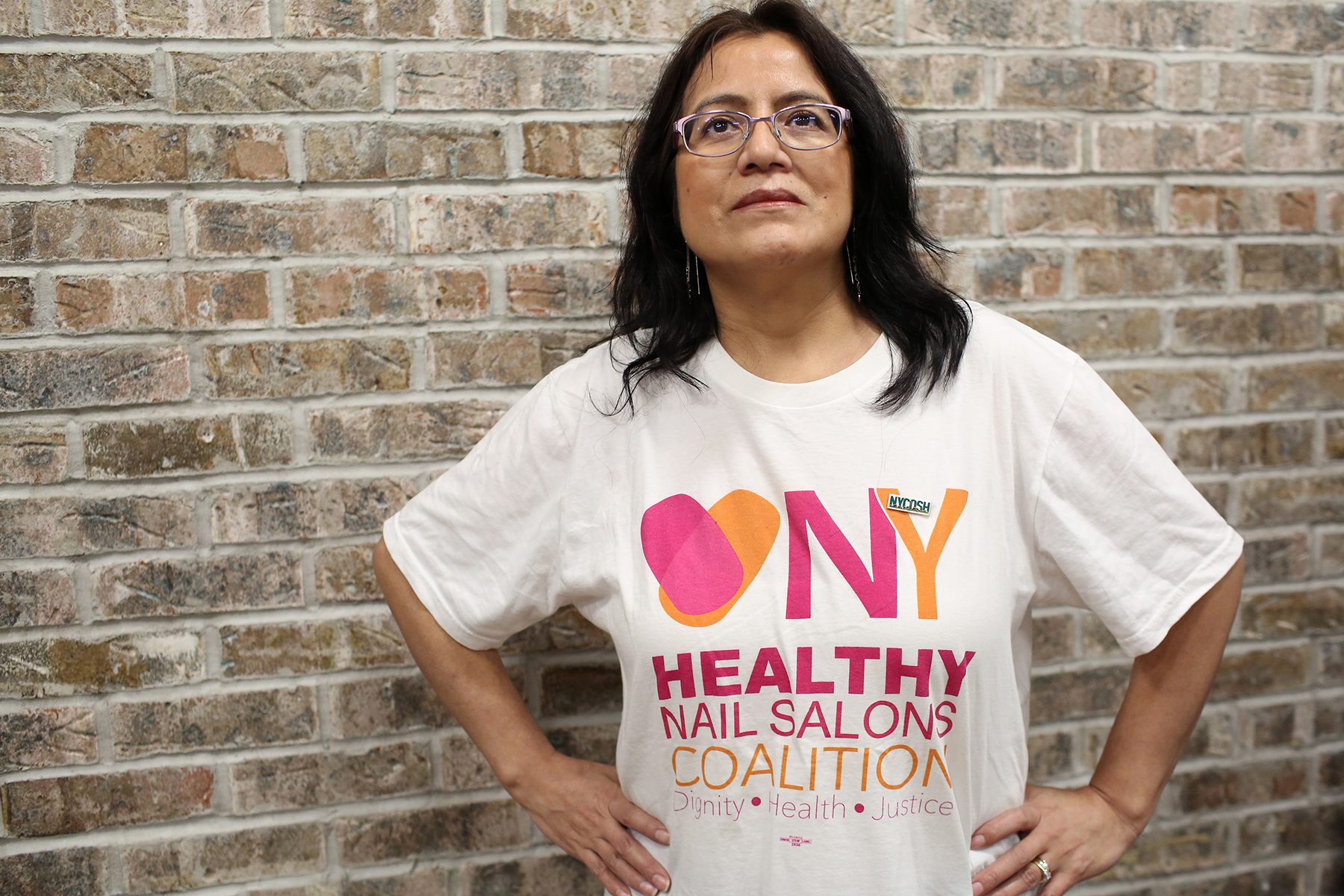
A worker who promised Vidal she’d speak at the rally didn’t show up that morning. Vidal had prepared her, told her what she could say, but when she called her ahead of the event, the worker backed out.
I’m afraid that my boss will retaliate against me, she’d told Vidal. I can’t speak because I can’t lose my job.
Vidal told her she understood, that she’d been through it, that she couldn’t tell her to come, that it was up to her.
She looked around at the crowd that was there. Can you do it, instead? she asked another nail tech.
Tell them what you have experienced and what is the change you want to see, Vidal told her. The meager pay. The indignities. The times her hours were slashed. The days she worked sick.
And the council that could change it all — that would finally hear her when she listed those grievances.
The nail tech had but five minutes before the speech.
I’m prepared, the worker replied. I’m going to speak.
